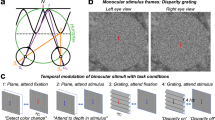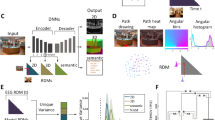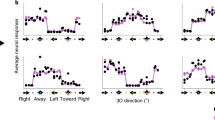Abstract
Mathematically, three-dimensional space can be represented differently by the cartesian, polar, and other coordinate systems. However, in physical sciences, the choice of representation system is restricted by the need to simplify a machine's computation while enhancing its efficiency1. Does the brain, for the same reasons, ‘select’ the most cost-efficient way to represent the three-dimensional location of objects? As we frequentlyinteract with objects on the common ground surface, it might be beneficial for the visual system to code an object's location using a ground-surface-based reference frame2. More precisely, the brain could use a quasi-two-dimensional coordinate system (x s, y s) with respect to the ground surface (s), rather than a strictly three-dimensional coordinate system (x, y, z), thus reducing coding redundancy and simplifying computations2,3,4,5. Here we provide support for this view by studying human psychophysical performance in perceiving absolute distance and in visually directed action tasks6,7,8,9,10,11. For example, when an object was seen on a continuous, homogeneous texture ground surface, the observer judged the distance to the object accurately. However, when similar surface information was unavailable, for example, when the object was seen across a gap in the ground, or across distinct texture regions, distance judgement was impaired.
This is a preview of subscription content, access via your institution
Access options
Subscribe to this journal
Receive 51 print issues and online access
$199.00 per year
only $3.90 per issue
Buy this article
- Purchase on Springer Link
- Instant access to full article PDF
Prices may be subject to local taxes which are calculated during checkout



Similar content being viewed by others
References
Shannon, C. E. & Weaver, W. The Mathematical Theory of Communication (Univ. Illinois Press, Urbana, 1949).
Gibson, J. J. The Perception of the Visual World (Houghton Mifflin, Boston, 1950).
Barlow, H. B. in Sensory Communication (ed. Rosenblith, W.) 217–235 (MIT Press, Cambridge, Massachusetts, 1961).
Attneave, F. Informational aspects of visual perception. Psychol. Rev. 61, 183–193 (1954).
Sedgwick, H. A. in Human and Machine Vision (eds Rosenthal, A. & Beck, J.) 425–458 (Academic, New York, 1983).
Thomson, J. A. Is continuous visual monitoring necessary in visually guided locomotion? J. Exp. Psychol. Hum. Percept. Perform. 9, 427–443 (1983).
Elliot, D. Continuous visual information may be important after all: a failure to replicate Thomson (1983). J. Exp. Psychol. Hum. Percept. Perform. 12, 388–391 (1987).
Steenuis, R. E. & Goodale, M. A. The effects of time and distance on accuracy of target-directed locomotion: does an accurate short-term memory for spatial location exist? J. Motor Behav. 20, 399–415 (1988).
Rieser, J. J., Ashmead, D. H., Talor, C. R. & Youngquist, G. A. Visual perception and the guidance of locomotion without vision to previously seen targets. Perception 19, 675–689 (1990).
Loomis, J., DaSilva, J., Fujita, N. & Fukusima, S. Visual space perception and visually directed action. J.Exp. Psychol. 18, 906–921 (1992).
Loomis, J., DaSilva, J., Philbeck, J. W. & Fukusima, S. Visual perception of location and distance. Curr. Dir. Psychol. Sci. 5, 72–77 (1996).
Jiang, Y. & Mark, L. S. The effect of gap depth on the perception of whether a gap is crossable. Percept. Psychophys. 56, 691–700 (1994).
Philbeck, J. W. & Loomis, J. M. Comparison of two indicators of perceived egocentric distance under full-cue and reduced-cue conditions. J. Exp. Psychol. Hum. Percept. Perform. 23, 72–85 (1997).
Cutting, J. E. & Vishton, P. M. in Handbook of Perception and Cognition: Perception of Space and Motion Vol. 6 (eds Epstein, W. & Rogers, S.) 69–117 (Academic, San Diego, 1995).
Mark, L. S. Eye-height scaled information about affordances: a study of sitting and stair climbing. J.Exp. Psychol. Hum. Percept. Perform. 13, 360–370 (1987).
Warren, W. H. & Whang, S. Visual guidance of walking through apertures: body-scaled information for affordances. J. Exp. Psychol. Hum. Percept. Perform. 13, 371–383 (1987).
Sedgwick, H. A. Combining multiple forms of visual information to specify contact relations in spatial layout. SPIE 1198, 447–458 (1989).
He, J. Z. & Nakayama, K. Apparent motion determined by surface layout not by disparity or by 3-dimensional distance. Nature 367, 173–175 (1994).
Acknowledgements
This research was supported in part by a Sloan Research Fellowship from the Alfred P. Sloan Foundation (to Z.J.H.) and by a Faculty Research Grant from SCO (to T.L.O.).
Author information
Authors and Affiliations
Corresponding author
Rights and permissions
About this article
Cite this article
Sinai, M., Ooi, T. & He, Z. Terrain influences the accurate judgement of distance. Nature 395, 497–500 (1998). https://doi.org/10.1038/26747
Received:
Accepted:
Issue Date:
DOI: https://doi.org/10.1038/26747
This article is cited by
-
The visual perception of long outdoor distances
Scientific Reports (2024)
-
The foggy effect of egocentric distance in a nonverbal paradigm
Scientific Reports (2021)
-
The influence of the availability of visual cues on the accurate perception of spatial dimensions in architectural virtual environments
Virtual Reality (2018)
-
Underestimation of large distances in active and passive locomotion
Experimental Brain Research (2018)
-
Following Safely on Curved Segments: A Measure with Discontinuous Line Markings to Increase the Time Headways
Iranian Journal of Science and Technology, Transactions of Civil Engineering (2017)
Comments
By submitting a comment you agree to abide by our Terms and Community Guidelines. If you find something abusive or that does not comply with our terms or guidelines please flag it as inappropriate.



